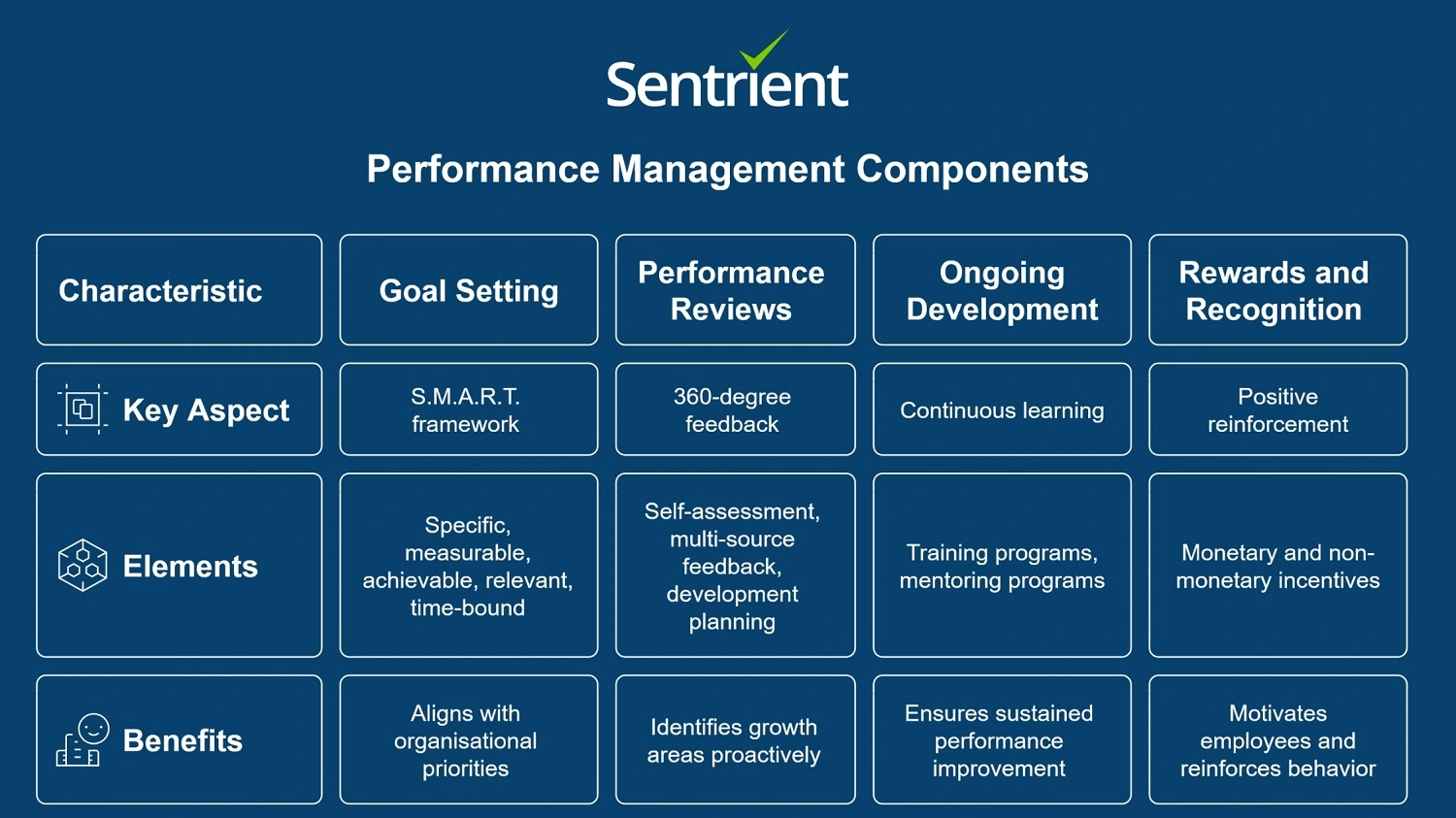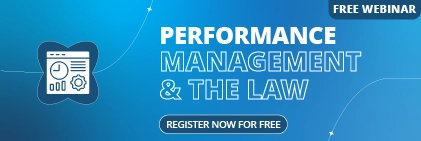Performance management is the backbone of thriving organisations, yet many struggle with outdated systems that fail to inspire or deliver results. We’ve found that traditional annual reviews often demotivate employees and miss opportunities for real-time improvement. The top companies, on the other hand, have revolutionised their approaches to performance management. They’ve done this through adopting continuous performance management systems that drive engagement and productivity.
We’ll dive into those secret strategies, offering HR and business owners reasonable insights and practical actions for transforming their performance management. From goal setting to leveraging top-of-the-line software like Sentrient, we’ll cover it all. Exploring the evolution, components, and best practices of performance management allows us to be more productive than ever before. By the end of this blog post, you’ll have a roadmap to create a high-impact system that aligns with your organisational goals and fosters a culture of growth.
The Evolution of Performance Management
Traditional Performance Appraisals
For far too many years, performance management relied on annual appraisal. These slow processes were where employees were evaluated based on past performance. These reviews often focused on accountability rather than growth, leading to several issues.
Delayed feedback is a common feature. Feedback delivered annually was often outdated, limiting its usefulness.
Emphasising past mistakes tends to discourage employees rather than inspire improvement. If you help your team learn and grow, you’ll find that your business will also grow.
Low engagement is another silent killer. Both managers and employees found the process time-consuming and uninspiring. If your team isn’t committed to a project, they aren’t going to give it their all. Inspiring your team and getting them to engage with business tasks will instantly boost productivity within the workplace.
The Shift to Continuous Feedback
Modern performance management emphasises continuous performance management, with regular feedback and development-focused conversations. These include several key elements.
Regular check-ins are crucial to ensure that your feedback remains consistent and ongoing. You should set up weekly or monthly meetings with your team to discuss progress. These meetings do not require formality; a brief check-in with individual employees can enhance their performance and productivity.
Goal alignment is another way you can keep your employees engaged. Ensuring individual goals support organisational objectives can be tough, but it’s a crucial part of performance management. By having individual goals align with company-wide goals, feedback for company projects will coincide with personal projects. Through this, continuous improvement allows your team to thrive.
Upskilling your workers is a great way to take advantage of continuous feedback and really allow them to put it into practice. This approach is more effective and lasting than punitive measures and also boosts their loyalty to the business.
These shifts allow for real-time adjustments and foster a more engaged workforce.
Drivers of Change
Several factors have fuelled the evolution in performance management. These include a tight labour market in the modern age. Companies need to keep employees happy if they want to retain their talent in such a competitive market. Businesses also need to be dynamic and agile, with rapid changes in workforce conditions needing dynamic performance management.
You’ll also need to have clear expectations of your employees. If your employees don’t know what’s expected of them, they won’t perform as well as they could. Workers also need growth opportunities and the ability to have a degree of autonomy over their work, so long as it meets company standards and needs.
These drivers highlight the need for HR managers to adopt more agile, employee-centric approaches.
Key Components of Effective Performance Management

1. Goal Setting
Effective goal setting in performance management is critical. Goals should follow the S.M.A.R.T. framework:
- Specific: Clear and well-defined. This should be direct and to the point, cutting out any corporate talk and getting straight to the issue.
- Measurable: Trackable with clear metrics. These should be quantifiable and are often KPIs or other relevant data points.
- Achievable: Realistic within resources and time. This helps ground the goal.
- Relevant: Aligned with organisational priorities. By doing this, you’re able to ensure that this goal will ultimately be beneficial for the company.
- Time-bound: Set with deadlines. If there’s no time limit, your workers won’t have any pressure or motivation to achieve the goal.
For example, a sales team might set a goal to increase revenue by 10% in six months, ensuring alignment with company objectives.
2. Performance Reviews
Regular performance reviews, incorporating 360-degree feedback, provide a comprehensive view of employee performance. These reviews should include self-assessment, multi-source feedback, and development planning. When employees reflect on their strengths and weaknesses, they can identify growth areas that managers might miss, addressing issues proactively.
Multi-source feedback provides feedback from peers, customers and managers. This helps identify and locate sources of improvement from all angles. Development planning involves long term upskilling and training programs for your employees. This accelerates their growth, and in turn makes your business more profitable on a per employee basis. Frequent reviews, such as quarterly, keep feedback relevant and actionable.
3. Ongoing Development
Continuous learning is vital for employee engagement. Strategies include training programs, where HR can organise formal courses or workshops to upskill employees. They can also set up mentoring programs, where employees are paired with experienced coaches or superiors to shadow for a day or a week. This focus on employee development ensures sustained performance improvement.
4. Rewards and Recognition
Rewards motivate employees and reinforce positive behaviour. These can include both monetary and non-monetary incentives. Monetary incentives often consist of bonuses or a raise, which are very effective, but also expensive for your business. A viable alternative can include recognition within the workplace, such as public praise or awards. These bonuses are more cost-effective for the business and can greatly motivate your employees. Non-financial rewards, like praise, can be as effective as monetary incentives.
The Performance Management Process
-
Planning
The process begins with setting clear expectations. Define job roles and responsibilities within your team, so everyone knows what they need to accomplish. Establish performance standards, so your team knows what level they must achieve, and set S.M.A.R.T. goals to ensure that everyone’s aligned. By implementing these simple steps, you’ll guarantee that your team will head into future projects with the right frame of mind. For instance, a marketing team might plan to launch a campaign by Q2, with specific KPIs they want to improve on compared to previous campaigns.
-
Monitoring
Regular monitoring ensures progress stays on track. Check in regularly to review your goals and ensure you’re on target. Use performance management tools such as Sentrient to automate goal tracking and KPIs. Be sure to provide timely feedback to address issues early, before they significantly impair any tasks or projects.
-
Development
Development addresses performance gaps and growth opportunities. Identify and specifically locate any training gaps with your performance data. This can be a tedious process, but the benefits are worth it. Offer coaching or mentorship projects, and within those opportunities, assign projects to newer staff. This helps them build not only new skills, but it also establishes their confidence in their skillset.
-
Rating & Rewarding
Formal assessments quantify performance and distribute rewards. Use predefined criteria for reviews to ensure a level playing field for all your staff. If you let biases enter your reviews, you’re setting yourself up for headaches in the future. Building on this, use 360-degree feedback to get a wide range of data and information. Reward excellence with raises, promotions, or recognition. Don’t punish underperformers, give them a chance to improve first.
This structured process ensures consistency and effectiveness.
Best Practices in Performance Management
-
Regular Check-ins and Feedback
Frequent check-ins, such as bi-weekly meetings, keep performance on track. They allow managers to address issues promptly, before they start to cause problems within the team. This also enables you to reinforce positive behaviours and further align individual efforts with overarching team and business goals.
-
Employee Involvement and Ownership
Involving employees in employee performance appraisal processes boosts engagement. Encourage self-assessments to foster accountability in your team. You should also encourage goal setting that helps align the team’s objectives with personal aspirations.
-
Data-Driven Decisions
Using data from performance management systems ensures objectivity. Tools like Sentrient provide analytics to track KPIs and milestones automatically, freeing up HR and allowing them to focus on broader company strategy. Data also helps identify trends in performance and inform training and resource allocation, ensuring you’re operating at peak efficiency.
-
Manager Training
Managers are pivotal to success. Training them in performance management best practices equips them to deliver useful, constructive feedback on the spot. This then transforms into setting effective goals and strong coaching for employees in a practical manner. Emphasise manager training to reduce conflict and enhance team performance.
Challenges and How to Overcome Them
-
Common Pitfalls
When implementing performance management, you may face challenges. Lack of manager buy-in, employee resistance, and time constraints are all known challenges of implementation. Untrained managers can resist new systems, while employees follow the lead of their superiors. Regular reviews often feel like a waste of time to those who don’t look to the long term.
-
Strategies for Success
To address these challenges:
- Offer comprehensive manager training programs.
- Communicate benefits to employees, emphasising growth opportunities.
- Integrate performance management into daily workflows using tools like Sentrient
- These strategies ensure smoother adoption and sustained success.
The Role of Technology
-
Performance Management Software
Tools like Sentrient streamline performance management implementation by offering features like customisable performance review templates, perfect for all departments in your business. They also offer goal tracking and real-time analytics, so you’re sure that all your data is up to date. Sentrient is tailored for Australian and New Zealand businesses, ensuring compliance and ease of use.
-
Choosing the Right Tools
Select software based on ease of use and integration as the main factors. Secondary considerations include customisation for organisational needs, which includes the ability to work with vendors to custom-match software for your business. Robust data security, as offered by Sentrient, is also extremely important in ensuring compliance with all laws and regulations.
Conclusion
Performance management is no longer about annual reviews but about fostering continuous growth and alignment. Top companies like Google and Adobe have shown that innovative strategies, such as OKRs (Objectives and Key Results) and frequent check-ins, drive engagement and productivity. By adopting best practices, leveraging tools like Sentrient, and addressing challenges, HR managers and business owners can create high-impact systems. Start by assessing your current approach, training managers, and exploring Sentrient’s features to transform your organisation’s performance management.
Quick Takeaways:
- Shift from annual reviews to continuous performance management.
- Focus on SMART goals, 360-degree feedback, and development.
- Use tools like Sentrient for streamlined, compliant performance management.
- Address underperformance early with clear plans.
FAQs
1. What is performance management?
Performance management aligns employee efforts with organisational goals through goal setting, feedback, and development. It allows businesses to ensure their employees are always working at their peak.
2. Why are traditional annual reviews ineffective?
They offer delayed feedback, focus on past mistakes, and often demotivate employees. Feedback given six months after a project is feedback too late.
3. What are S.M.A.R.T. goals?
S.M.A.R.T. goals are Specific, Measurable, Achievable, Relevant, and Time-bound, ensuring clarity and focus. This framework is essential when setting goals within the business.
4. How can technology help in performance management?
Tools like Sentrient automate goal tracking, reviews, and feedback, enhancing efficiency. Technology allows for work to be shifted off HR, freeing them up to work on other vital aspects of the business.
5. What is 360-Degree feedback?
It gathers input from peers, subordinates, and managers for a comprehensive performance view. This helps eliminate bias in performance reviews and makes sure that your employees are being judged fairly in all aspects of performance.
6. How often should performance reviews occur?
Quarterly or monthly reviews, supplemented by weekly check-ins, ensure timely feedback. These can be scheduled more frequently for more dynamic or volatile roles.
7. What role do managers play in performance management?
Managers set goals, provide feedback, and coach employees to align with organisational objectives. Managers are the glue holding the team together. If your managers aren’t engaged, your employees will suffer.
8. How does performance management improve engagement?
Clear goals, recognition, and development opportunities boost performance management and employee engagement. Employees who are actively engaged in their work demonstrate strength and commitment.
9. What are common performance management challenges?
Issues include untrained managers, employee resistance, and time constraints, solvable with training and tools. These issues are very prevalent and can pose significant risks if not properly addressed.
10. What are the future trends in performance management?
Trends include AI, predictive analytics, and systems tailored for performance management for remote teams. The future is constantly evolving, and you don’t want to be left behind.
Read More About Performance Management:
- Performance Management for Millennials and Gen Z: Key Insights for HR and Owners
- Performance Management: Managing Underperforming Teams Effectively
- Performance Management in Startups: Challenges and Best Practices
- How to Build a High-Performing Team Through Effective Performance Management
- 10 Essential Performance Management Practices for Leaders





